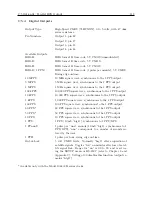
130
Options List
C.10
Option 12: OCXO and Four Additional Outputs
C.10.1
General Description
Option 12 for the Model 1088A/B adds a disciplined oven-controlled crystal oscillator (OCXO)
having stability of 1 part in 10
7
over temperature, and four additional configurable outputs.
C.10.2
Specifications
General
Output Connectors: BNC-type RF connectors (4).
Oscillator:
Oven-controlled, 1x10
−
7
, from 0 to 50
◦
C.
C.10.3
Firmware Setup for Option 12
Hardware and firmware configuration of the Model 1088A/B is performed at the factory when this
option is ordered at the same time as the clock. The following instructions are intended primarily
for field installation or maintenance. In addition, if the instrument configuration is ever reset to
factory default settings, then this initialization will need to be performed so that the units firmware
will automatically recognize the Option 12 assembly.
To change the firmware setup for Option 12, use the SETUP menu of the Model 1088A/B. Press
the SETUP key repeatedly until SET OPTION BOARD appears in the display. Press ENTER,
and then press the UP key until OPTION 12 appears. Press ENTER again, and select the option
(if any) present in the B option slot of the unit. Press ENTER again. This completes the firmware
configuration for Option 12. More information about instrument firmware configuration with the
SETUP menus is found in section 5 of the Model 1088A/B Operation Manual.
C.10.4
Main Board Setup via Internal Jumpers
Hardware and firmware configuration of the Model 1088A/B is performed at the factory when
this option is ordered at the same time as the clock. The instructions, which follow are intended
primarily for field installation.
Case Removal:
To change the main board configuration for Option 12, the top cover of the instrument must be
removed. Turn off the instrument, and disconnect the power cord. Using a T-25 torx driver, remove
the four screws holding the cover (and rack mount ears, if used) in place, and lift the cover off.
WARNING
Do not remove the top cover while power is applied. Hazardous voltages are present
while the power cord is connected. Always disconnect the unit from the input power source before
removal of the top cover.
Jumpers 2 and 3 of the main board assembly (see Figure 5.1) must be set properly to allow the
Option 12 oscillator to drive the clock. The setting for Jumper 2 should be changed to B (External
Reference) and the setting for Jumper 3 should be changed to B (5 MHz). When these settings
have been completed, reinstall the instrument cover and reapply power.
Summary of Contents for 1088A
Page 4: ...iv ...
Page 6: ...vi ...
Page 18: ...xviii LIST OF FIGURES ...
Page 23: ...1 4 Attaching Rack Mount Ears to 1088A B Series Clocks 3 Figure 1 2 Attaching Rack Mount Ears ...
Page 24: ...4 Unpacking the Clock ...
Page 32: ...12 Front and Rear Panels ...
Page 38: ...18 Connecting Inlet Power Input and Output Signals ...
Page 46: ...26 GPS Antenna and Cable Information ...
Page 48: ...28 Setting Internal Jumpers Figure 5 1 Model 1088B Main Board ...
Page 76: ...56 The Setup Menus ...
Page 112: ...92 Serial Communication and Command Set ...
Page 127: ...B 4 Physical Dimensions 107 Figure B 1 Suggested Mounting of the AS0094500 Surge Arrester ...
Page 128: ...108 Using Surge Arresters ...
Page 145: ...C 5 Option 04 Parallel BCD Output 125 Figure C 4 Option 04 Output Jumper Settings ...
Page 146: ...126 Options List Figure C 5 Option 04 Board Layout and Jumper Locations ...
Page 166: ...146 Options List Figure C 12 Option 17 Board Layout and Jumper Locations ...
Page 187: ...C 16 Option 20A Four Fiber Optic Outputs 167 Figure C 22 Option 20A Jumper Locations ...
Page 194: ...174 Options List Figure C 24 Option 23 Internal Jumper Setup ...
Page 196: ...176 Options List Figure C 25 Option 27 Jumper Locations ...
Page 214: ...194 Options List Figure C 28 Option 29 Connector Signal Locations ...
Page 270: ...250 Options List ...
















































